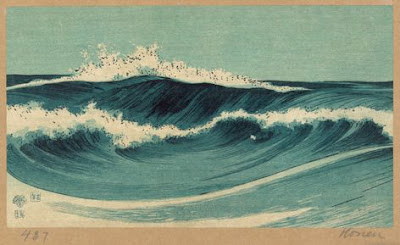Koshiro Onchi
(1891-1955)
Japanese printmaker, poet,
publicist, book designer.
Man of many talents.
Founding father of Sosaku Hanga*
Man of many talents.
Founding father of Sosaku Hanga*
today, as promised in before last posting, I'll try to show an overview of the many talents of this Japanese printmaker with the most relevant text borrowed from Floating World Gallery* (see end of posting).
Born in Tokyo 1891, graduated in 1909 from the middle school for German studies in Tokyo and after failing examination to enter Daiichi Kotogakko (First High School), studied oil painting at Aoibashi branch of school of Hakubakai.
Onchi entered Tokyo School of Fine Arts in 1910, studying first oil painting and then sculpture. In 1911 he withdrew from the school and obtained a job as a book designer.In 1912 he was readmitted to Tokyo School of Fine Arts. In October 1913 he began planning the print and poetry magazine Tsukubae, created numerous abstract prints and directed publication of 7 issues 1914-1915.
Onchi contributed cover designs, poems, and moku-hanga, in 1917 Onchi published his first collection of prints, Happiness (Kofuku). In 1919 he participated in the first Nihon Sosaku-Hanga Kyokai exhibition and in 1921 began publication of the general art magazine Naizai with Otsuki Kenji and Fujimori Shizuo.
Over the years Onchi was also active in producing and promoting other poetry and print magazines to which he contributed poems, prints, graphic design, and articles promoting the idea that printmaking is a legitimate expressive and creative medium, not merely a means of reproduction.
Over the years Onchi was also active in producing and promoting other poetry and print magazines to which he contributed poems, prints, graphic design, and articles promoting the idea that printmaking is a legitimate expressive and creative medium, not merely a means of reproduction.
The coffee house and the dance room
A major force in the Sosaku-Hanga* movement and the leading abstract print artist of his time in Japan. Sometimes used the signature ONZI on early prints.
*Susaku Hanga, the movement in Japanese printmaking re-introducing "draw it yourself, cut and print it yourself" away from the collaborative printmaking of Ukiyo-E or "floating world" printmaking, where professional cutters and printmakers executed the design in a combined effort. The movement started with Kanae Yamamoto's (1887-1946) Fisherman of 1904, shown in the Blog here*.
For a detailed biography read here* and also: Merritt, Helen and Nanako Yamada. Guide to Modern Japanese Woodblock Prints: 1900-1975. University of Hawaii Press: Honolulu. 1992.All pictures borrowed freely from the www. for friendly, educational, intellectual non commercial use.




























+Heavy+Sea.jpg)





.+Zoo+in+Spring.jpg)














